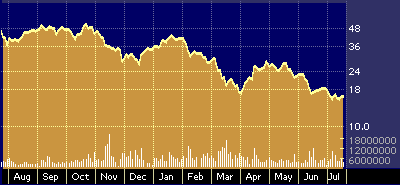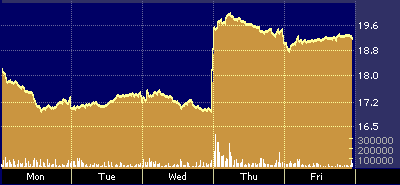
Solectron Stock Set to Soar in 2nd Half
Solectron Stock Set to Soar in 2nd Half
By Hal Plotkin
Silicon Valley Correspondent
Some analysts — spurred on by recent comments made by the company’s chief executive officer and president Koichi Nishimura — say Solectron Corp.’s {SLR} stock could regain its momentum during the second half of the year.
During his presentation last week at the Robertson Stephens Electronic Manufacturing and Products Conference in San Francisco, Nishimura said that he is confident that several factors will combine to extend his company’s growth well into the future.
“We believe the opportunities available to us are now even greater than before,” Nishimura told attendees during his presentation.
The Solectron executive cited expectations for continued strong demand for outsourced manufacturing, as well as his firm’s move to offer after-sales service and support, such as warranty and product-repair services.
The company’s once sector-leading stock has given investors more than a few headaches during the past year. The stock was hit particularly hard over the past few quarters by earnings guidance that left some analysts confused and others disappointed.

Solectron 52-Week Stock Performance Chart
Analysts’ concerns centered on the rate of Solectron’s organic growth vs. growth achieved through recent acquisitions. Some analysts felt Solectron’s executive team had been too optimistic regarding the speed with which the company’s newly acquired manufacturing facilities would contribute to the bottom line.
“Frankly, there were some who were beginning to question the company’s integrity,” says one analyst who prefers to remain anonymous.
The stock took another hit late last week after the big Nokia Corp. {NOK} selloff, which was related to guidance that firm gave regarding pressure on its earnings moving forward.

Nokia Five-Day Stock-Performance Chart
Although Solectron has a huge, diverse customer and product base, the company’s reputation as a leading maker of inexpensive cell phones didn’t help, given the more-restrained outlook now emerging for that industry.
Based in Milpitas, Calif., Solectron manufactures electronics products for many blue-chip customers, such as Cisco Systems Inc. {CSCO}, Hewlett-Packard Co. {HWP} and International Business Machines Corp. {IBM}. All told, the company has more than 150 customers, many of whom, such as IBM, have been with it for more than a decade. The company benefits from high utilization of its plants and equipment created by its diverse customer base.
“Solectron picks the right companies to work with,” says Shelby Fleck, a principal at Morgan Stanley Dean Witter in New York.
California-based Dataquest projects outsourced manufacturing, which topped $89 billion last year, will grow by more than 25 percent a year between now and 2003.
In an exclusive CNBC.com interview conducted after his formal presentation, Nishimura added that he expects Solectron to increase its after-market services revenue to up to 15 percent of sales in five years, up from less than 1 percent today.
“We’re starting off a very small base, so I expect it will grow rather quickly,” Nishimura says.
Some analysts say that the uncertainty surrounding the stock’s recent performance has created an unusually good buying opportunity.
“Solectron is trading at about a 20 percent discount to its group,” says J. Keith Dunne, an analyst at Robertson Stephens. “But I believe the numbers they’re talking about now are very achievable and could go even higher. So I think we’ll be looking at a rise in a major way to rectify that.”
Dunne says it is only a matter of time until investor psychology catches up with the reality of Solectron’s performance moving forward.
What’s more, Dunne adds that fears of marked cyclicality in the outsourced manufacturing industry, which lead some investors to periodically get in and out of such stocks rather than simply buy and hold, have been proven to be outdated.
“During the last downturn, the Asian contagion in ‘97 to ‘98, many predicted a downturn in outsourcing,” Dunne notes. “Instead, it accelerated. I think that’s something many people don’t understand.”
Dunne adds that Solectron does well when the economy is hot, for obvious reasons, but it also thrives during down cycles as original equipment manufacturers seek to cut costs by shutting or selling off their own manufacturing plants and outsourcing more of their own product needs.
Solectron’s practice of charging its customers to carry inventories of supplies and components on their behalf also serves to insulate the company from potentially damaging macroeconomic trends, Dunne says.
“Even if a we do see a recession, Solectron’s balance sheets self-liquefy and start throwing off tons of cash,” Dunne says.
Dunne, who hasn’t published a price target on the stock, rates it “buy” and says he is looking for a particularly strong performance as analyst concerns begin to subside over the next six months.
David Parrish, an analyst at Dain Rauscher Wessels in Boston, agrees.
Parrish also has a “buy” rating on the stock, along with a price target of 50, which he says will likely be revised upward if Solectron’s results for the fiscal year ending Aug. 25 and due for release on Sept. 11, hit the high end of analysts estimates at or above 87 cents a share.
“From my vantage point, it’s a high-quality company that we consider a core holding,” Parrish says. “I think it’s relatively attractive [at its current price].”
Parrish agrees that Solectron was hurt by giving too ambitious guidance regarding anticipated performance related to its recent acquisition of manufacturing facilities from Nortel Networks Corp. {NT}.
“They deserve to be at a discount because of all that controversy,” he says. “But it sounds like the current quarter is going well.”
Tom Cal, an analyst with Wit SoundView, based in Stamford, Conn., also has a “buy” rating on the stock but hasn’t recently calculated a price target.
“The company is continuing to grow both earnings and revenue at a decent clip,” Cal says. “We’re very confident top-level demand will also continue to grow at a fast clip.”
Cal adds that he is a little worried that Solectron’s return on capital has shown signs of a decline, a trend he says the company needs to reverse.
In addition, Cal says that Solectron’s senior management team will have to do a better job managing expectations among Wall Street analysts to get proper credit for their accomplishments.
“If they can once again demonstrate their ability to meet or beat the estimates, at some point the stock will be poised to do well,” Cal says. “But they need to win back the glow they had a year ago.”
Dunne is convinced it will happen. He says that Solectron’s recently formulated plan to augment its revenue base by as much as 15 percent in five years with after-sales service and warranty support would be icing on the cake.
“I think that’s another source of upside for them,” Dunne says. “I don’t have those kinds of numbers in [my projections]; I’m in single digits on the after sales, so that would be on top of my estimates. But to a large degree, it’s a very natural extension of what they do. It’s what the customers are asking for, and it makes a lot of sense.”
“The outsourcing trend can’t continue to grow forever,” Cal says. “But it should be good for maybe another 10 years or so.”
On June 12, Solectron reported earnings of 20 cents a share on revenues that grew by 51.8 percent year over year for the company’s fiscal third quarter ended May 26.


